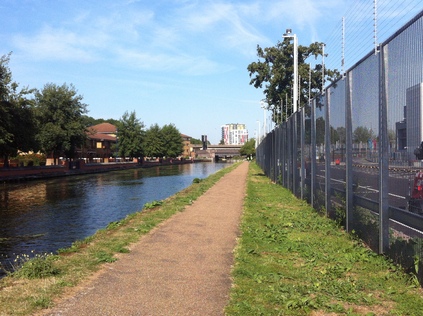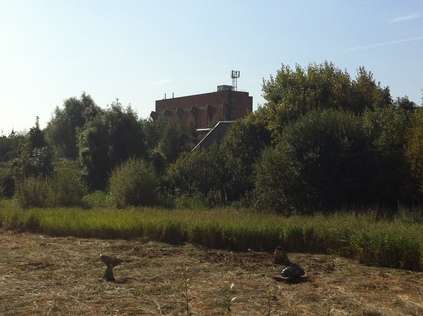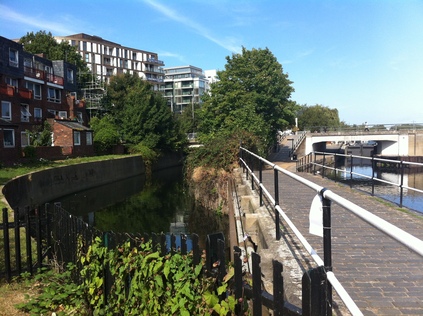
The Circle Completed - The Lower Lea Valley
Posted in London on Saturday 15th September 2012 at 11:09pm
The difference today was that I had at least planned to be here. My year planner is peppered with these trips to London in the safe knowledge that they will find me exploring some new geographical obsession or other, and that I'll have a reasonably relaxing journey on the rails. Sometimes, they become little excursions beyond the city - but even then there is always the luxury of an early arrival and perhaps a bus ride. With the world of railtouring changing considerably there have been more trips than I ever quite planned, but this has lead to walks across the eastern side of the city I'd probably not have countenanced before too. In this sense at least, the fractured and haunted summer has been a success in retrospect and I look back fondly on those walks which sometimes didn't seem significant on the day, but which have clicked into place later. I could only hope today would do the same for me. Because, today I had half a plan.
Today was, essentially, a completion. I'd read online that the towpath along the Hackney Cut was open - if still patrolled by G4S around the Olympic Park perimeter. But it was open nonetheless, so after a lazy breakfast in welcome late summer sunshine I set off east on my usual bus route. It was quiet, a cool but shining morning as we headed around the arc of the bus route. I saw it through almost to its end, hopping off near Bow Garage for the walk to the Church. I stocked up on water too, it looked like later when the sun was high it was going to be hot. I dodged traffic at Bow Interchange and found the footbridge down to the towpath just how I'd seen it on that excursion months back. I pondered what that had started: campaigns, obsessions, imaginary love affairs, endless wanders. I descended slowly, savouring this progression onto what had become hallowed ground. A battle fought over a strip of scraggy land beside a turgid canal, walkers and cyclists uneasily united. It was good to be back. Quickly, The Fence is alongside. Beyond it? Nothing. No movement. The occasional distant crash or scrape as unseen contractors strip back "the overlay" from the park. Empty staff buses circuit, the contract outliving their usefulness. Occasional security cars emerge. Overhead, a helicopter constantly drones. Crossing and recrossing the park. Even now it's a focus for paranoia and concern. I walk on, past the Northern Outfall Sewer carrying the still off-limits Greenway, past Hertford Union Junction, White Post Lane. I'm on the stretch which was guarded when a small orange boat called "Vigilance" passes by. They're not interested anymore. I stop, take a picture, watch the sun bounce of the gilt lettering of Formans, speculators on the Olympic dream. I could oppose Lance Forman's take on the Games, but he's still here in the Wick, his modern but organic new headquarters swooping gracefully and cheekily nodding at the Orbit across the water. Finally I reach the closure point - further than I ever managed on this side. The little brick circle still allows cyclists to pause and read maps. The boat ties off here, the lime green shirted guards head into the park. I make a decision - I'll press on out of its gravity - I'll get free of this place at last...


The last stretch is hard going - but is oddly rewarding. Busy boat houses provide a home for the canoes and rowing vessels which have passed me all morning, receiving commands from bicycling captains with loud-hailers. There has been a post-Olympic surge here, the junior section in particular is busy. Whatever the skepticism I might hold about the Games and this swathe of London, it's genuinely heartening to see this. On the east bank Springfield Marina is full of a different kind of vessel - a life on narrowboats always seemed a corny cop-out, but now I see it's attractions more clearly. Is this another mid-life crisis looming? I pause to finally empty my aching bladder at Markfield Park Cafe, in the shadow of the great Beam Engine. This one dealt in the pumping of sewage - part of the scheme which cleansed London of its filth, now regenerated into a rather fine little corner of the parkland with a museum, a cafe and places to relax and play. It felt positive and well-used. I considered lunch here, but again thought that stopping might be final. I returned to the path for the last push. Under the railway again, the curve to South Tottenham breaking off just feet from the river and the Cambridge line passing directly overhead. The river turns north and the Gospel Oak to Barking line crosses on a low bridge. Some young black guys explode from a side gate swaggering and yelling. I glance at one and with little interest he utters "Yeah. Come on then? What you gonna do then?". It's momentarily startling, but empty. He rails against everyone I guess, but fat white middle-class guys tramping river banks must be appalling to him. I press on, waiting for another walker to pass me before checking they headed in the opposite direction. Its the one time I've been even mildly concerned for my safety on the riverbank I realise. Finally, Tottenham Lock hoves into view - but just before it does, the path rises over a side-stream. Curving away in a concrete culvert is Pymmes Brook. It's an inauspicious little rivulet. Dirty and slow-moving in it's stony gully. But this leads onwards towards Tottenham where the tiny trickle of the Moselle River joins it. I have linked up with an earlier walk and it's strangely triumphant to think how there is coherence to my ramblings. I ascend to civilisation with some regret...there is more river to walk ahead, but not today.

I realise I'm hungry and thirsty, and raid the newly opened Tesco near the station. Its a strange corner of public-private land here with fine new flats, a gym and a supermarket all protected by an ugly 1980s security kiosk - unmanned of course. No alcohol allowed. I munch pastries and glug fruit juice, wondering if this is allowed. Finally, dusted off and replete, I head for a train back to Liverpool Street and welcome coffee. I also realise that I booked a much later train than usual home - so there's no hurry, and I decide to use the buses to cross and recross the territory I've walked. To get a different slant on the land I've carved through by river. Thus I find myself crossing Lea Bridge and looking down on the spot I regarded it from earlier before arriving at Walthamstow Bus Station. A drunk has stumbled into a slow moving bus, an ambulance in attendance. Ill-governed crowds crush and flock to buses. I make the back seat of a 69 to Canning Town, wedged up against a tiny but pretty Polish mother. This bus takes me via Leyton, the eastern edge of the Olympic Park pushed up against the homes and shops of the borough. It's another circle complete - and another set of possibilities and gateways opened. What started with uncertain rail journeys before the bid, turned into a curious regard for this strange strip of land, and now manifests itself as an urge to walk, has come full-circle. This is now a voyage into post-Olympic London. Legacy delivered or reneged on? I find myself already wanting to be back here.
You can see more pictures from the walk here. As an experiment, you can also follow the route on the map below - the blue line is the walking route.
View Lower Lea Valley Reconnected in a larger map
Lost::MikeGTN
I've had a home on the web for more years than I care to remember, and a few kind souls persuade me it's worth persisting with keeping it updated. This current incarnation of the site is centred around the blog posts which began back in 1999 as 'the daylog' and continued through my travels and tribulations during the following years.
I don't get out and about nearly as much these days, but I do try to record significant events and trips for posterity. You may also have arrived here by following the trail to my former music blog Songs Heard On Fast Trains. That content is preserved here too.

